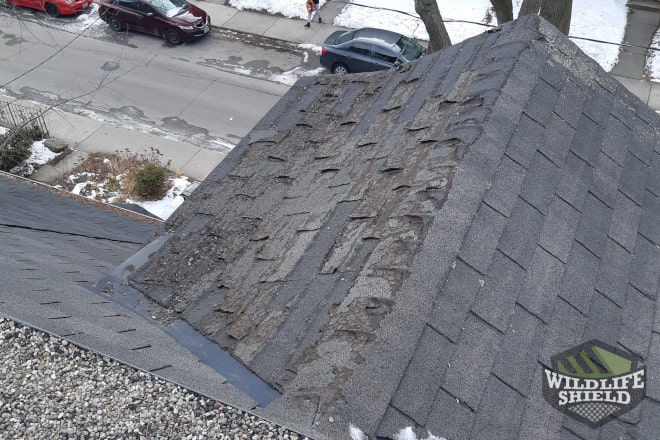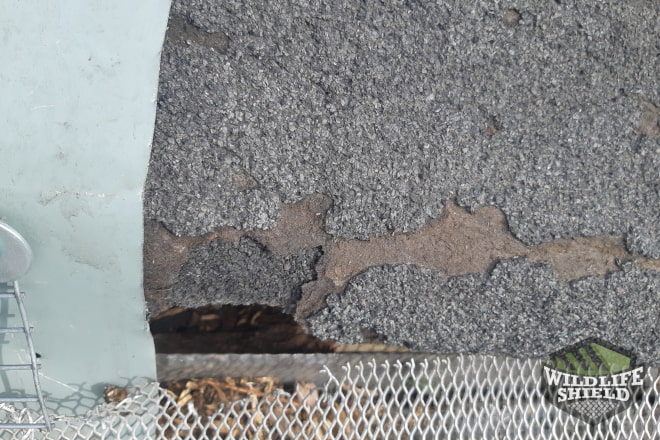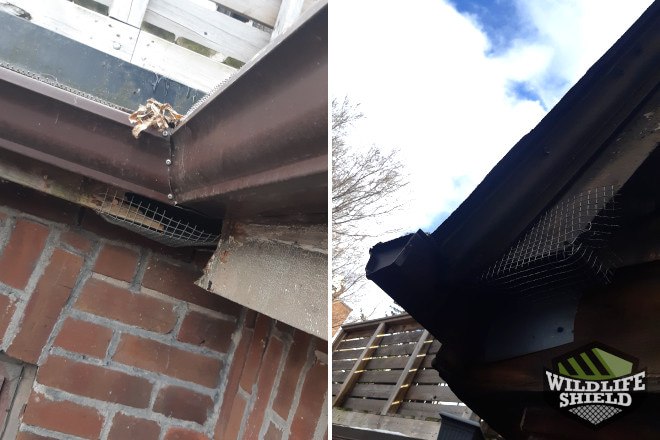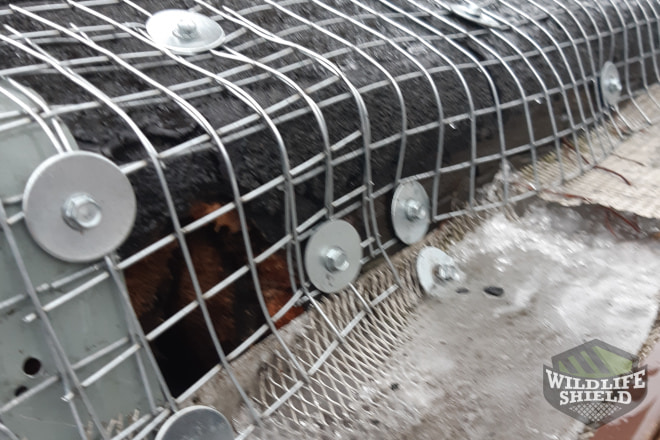The following case study describes a squirrel removal job in Old Toronto. In February, a squirrel chewed its way through a shingle on a century home’s roof so it could nest in the attic. To remove it, a technician installed a one-way door to the squirrel’s opening, then excluded the rest of the roof to keep the animal out for good. If you suspect that a squirrel has broken into your attic, give us a call. We provide comprehensive squirrel removal services throughout the Greater Toronto Area.
Inspection
The first step of any squirrel removal is to inspect the property from top to bottom. Upon arrival, the technician examined the roof for signs of squirrel damage and points of entry. This would identify where the squirrel was getting into the attic and where it could come back in the future, so our technician could get the squirrel out quickly and prevent it from coming back. A full inspection is necessary for an exceptional service.
Here, the roof was in need of repair. The shingles were worn, and there were openings along the edges of the gutters. As its name would suggest, Old Toronto is full of old homes. With time, the rooves on these properties split, crack, and give way to wildlife. The squirrel in this case had chewed its way through an old shingle on the edge of the second storey roof.


To remove the squirrel, the technician recommended having a one-way door installed. This is our go-to solution to squirrel invasions. It’s totally humane, and very effective. Like an open-ended trap, the door swings outward, letting the squirrel out, then it shuts in a way that the squirrel cannot get back inside. The technician would simply screw the door onto the squirrel’s opening and the animal would be gone in a few days or weeks.
In addition to the one-way door, the technician recommended having some exclusion work done. This involves the sealing and covering of all other potential entry points, such as wall vents, roof vents, soffits, and gaps in the roof’s edge. The technician also suggested having some gutter guards installed to help keep squirrels away from the roof and prevent the downspouts from blocking.
The homeowner agreed to have the squirrel removed with the one-way door, then to exclude parts of the roof to keep it safe from wildlife. To access the roof safely, two members of the Squirrel Control team got to work right away.
Removal and Exclusion
Right away, the technician installed the one-way door onto the hole in the shingles. What made this entry point obvious was the presence of teeth marks surrounding the hole. The homeowner had also reported hearing noises coming from that direction inside the house. The technician screwed the door right into the roof so that it wouldn’t budge if the squirrel tried to get back inside.
Next, the technician sealed some vulnerable edges in the roof with mesh. Old wooden soffits were covered with mesh to keep squirrels and raccoons from tearing them, and holes in the roof were blocked with mesh as well.

Within a few weeks, the homeowner stopped hearing noises in the attic. The squirrel living inside it had left and found another place to live. A technician then returned to the scene to remove the door and replace it with mesh.

Conclusion
Squirrels nest in trees, but they will happily nest in your attic when given the chance. Old rooves and century homes are especially prone to these invasions. The squirrel in this case chewed its way through an old shingle on the side of the roof so it could nest in the attic. Call us if you are worried about the squirrels in your area. We can squirrel-proof your roof to ensure that no animals break in. If there are squirrels in your attic, we can remove them humanely. Call us today for an inspection.